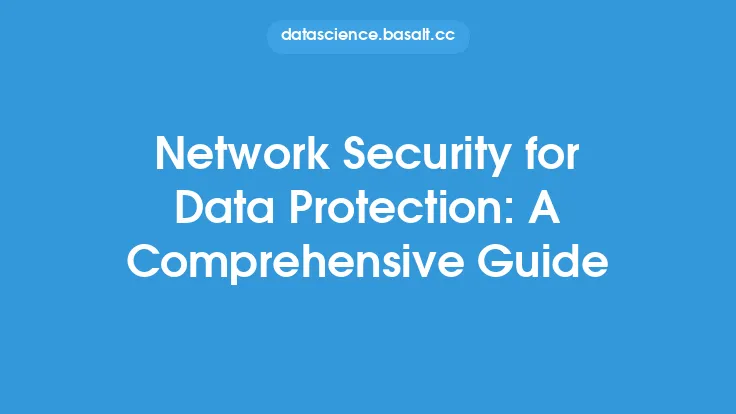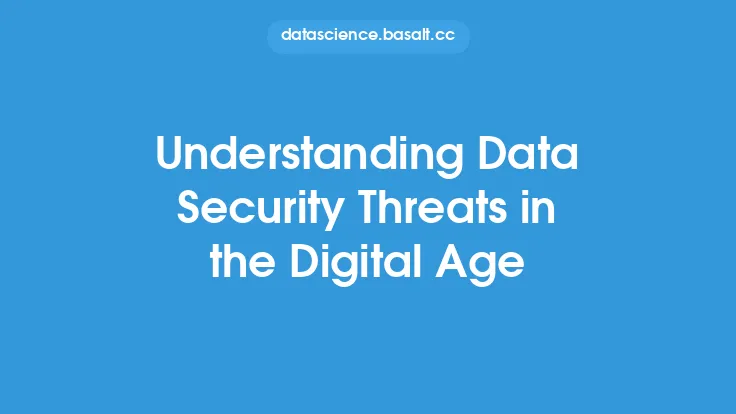The world of data security is a complex and ever-evolving landscape, with new threats and vulnerabilities emerging every day. As technology advances and more data is generated, the need for robust security measures to protect sensitive information has never been more pressing. In this article, we will delve into the various data security threats and vulnerabilities that organizations and individuals face, and provide a comprehensive guide on how to mitigate these risks.
Types of Data Security Threats
Data security threats can be broadly categorized into several types, including malware, phishing, denial-of-service (DoS) attacks, man-in-the-middle (MitM) attacks, and insider threats. Malware, such as viruses, Trojans, and ransomware, can compromise data by encrypting or deleting it, or by stealing sensitive information. Phishing attacks, on the other hand, involve tricking individuals into revealing sensitive information, such as passwords or credit card numbers, through fake emails or websites. DoS attacks overwhelm a system with traffic, rendering it unavailable to users, while MitM attacks involve intercepting and altering communication between two parties. Insider threats, which can be intentional or unintentional, occur when authorized personnel compromise data security, either through malicious actions or negligence.
Common Data Security Vulnerabilities
Data security vulnerabilities can arise from various sources, including software vulnerabilities, hardware vulnerabilities, and human error. Software vulnerabilities, such as buffer overflows and SQL injection, can be exploited by attackers to gain unauthorized access to systems or data. Hardware vulnerabilities, such as those found in IoT devices, can provide an entry point for attackers to compromise entire networks. Human error, such as weak passwords, poor security practices, and social engineering, can also lead to data breaches. Additionally, vulnerabilities can arise from outdated software, misconfigured systems, and lack of security patches.
Network Security Threats
Network security threats are a significant concern for organizations, as they can compromise the confidentiality, integrity, and availability of data. Common network security threats include packet sniffing, which involves intercepting and analyzing network traffic, and DNS spoofing, which involves redirecting users to fake websites. Other network security threats include Wi-Fi hacking, which involves exploiting vulnerabilities in wireless networks, and VPN hacking, which involves compromising virtual private networks. To mitigate these threats, organizations can implement robust network security measures, such as firewalls, intrusion detection systems, and encryption.
Cloud Security Threats
Cloud security threats are a growing concern, as more organizations move their data and applications to the cloud. Common cloud security threats include data breaches, which can occur due to inadequate access controls or encryption, and account hijacking, which involves compromising cloud accounts to gain unauthorized access to data. Other cloud security threats include insecure APIs, which can provide an entry point for attackers, and lack of visibility, which can make it difficult to detect and respond to security incidents. To mitigate these threats, organizations can implement robust cloud security measures, such as encryption, access controls, and monitoring.
Mobile Security Threats
Mobile security threats are a significant concern, as mobile devices are increasingly used to access sensitive data. Common mobile security threats include mobile malware, which can compromise data and devices, and phishing attacks, which can trick users into revealing sensitive information. Other mobile security threats include unsecured Wi-Fi networks, which can provide an entry point for attackers, and lack of encryption, which can compromise data in transit. To mitigate these threats, individuals and organizations can implement robust mobile security measures, such as encryption, secure browsing, and regular updates.
Mitigating Data Security Threats and Vulnerabilities
To mitigate data security threats and vulnerabilities, organizations and individuals can implement various measures, including risk assessments, vulnerability management, and incident response planning. Risk assessments involve identifying potential threats and vulnerabilities, while vulnerability management involves remediating vulnerabilities through patches and updates. Incident response planning involves developing a plan to respond to security incidents, such as data breaches or system compromises. Additionally, organizations can implement security awareness training, which can educate employees on security best practices and phishing attacks.
Best Practices for Data Security
Best practices for data security include implementing robust access controls, such as multi-factor authentication and least privilege access, and encrypting data both in transit and at rest. Organizations can also implement regular security audits and penetration testing, which can help identify vulnerabilities and weaknesses. Additionally, individuals and organizations can implement secure coding practices, such as secure coding guidelines and code reviews, to prevent vulnerabilities in software applications. Finally, organizations can implement a culture of security, which involves educating employees on security best practices and promoting a security-aware culture.
Conclusion
In conclusion, data security threats and vulnerabilities are a significant concern for organizations and individuals, and can have severe consequences, including data breaches, financial loss, and reputational damage. By understanding the various types of data security threats and vulnerabilities, and implementing robust security measures, such as risk assessments, vulnerability management, and incident response planning, organizations and individuals can mitigate these risks and protect sensitive information. Additionally, by following best practices, such as implementing robust access controls, encrypting data, and promoting a culture of security, organizations can ensure the confidentiality, integrity, and availability of their data.





